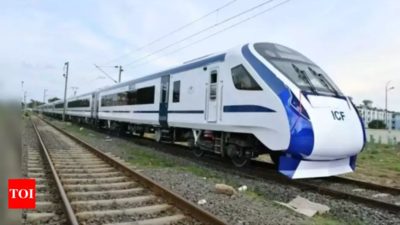Top Searches
- News
- City News
- mumbai News
- 5 hours, 14 minutes for Ahmedabad-Mumbai trial of Vande Bharat
5 hours, 14 minutes for Ahmedabad-Mumbai trial of Vande Bharat

Vande Bharat Express (File photo)
MUMBAI: The Vande Bharat Express, semi-high speed intercity train, conducted a successful trial run on the Ahmedabad-Mumbai route on Friday, clocking five hours and 14 minutes to cover 491km non-stop from Ahmedabad to this city. On the return journey, it clocked five hours and four minutes, officials said.
Since it was without halts, once the clearances are in place and a timetable is drawn up with halts en route, the total time taken to travel between the two cities could be around six hours, sources said. Senior officials refused to comment on the "actual time" which the train will take to cover the distance as a timetable was yet to be finalised.
The train will need a final clearance from the Chief Commissioner Railway Safety after the trial runs and officials hope the final launch is by Dussehra or Diwali. The railway ministry is spearheading the Vande Bharat project, a Make-in-India initiative.
A few faster trains on this route are Shatabdi and IRCTC's Tejas Express. Shatabdi leaves Mumbai Central at 6.10am and reaches Ahmedabad at 12.25pm in six hours and 15 minutes. Similarly, Tejas leaves at 3.45pm and reaches Ahmedabad at 10.05pm six hours and 20 minutes.
Sources said the Mumbai-Ahmedabad bullet train in future is expected to cover the same distance in 2-3 hours and will run at a speed of 320kmph.
During the trial run of Vande Bharat on Friday, the maximum speed en route was 130kmph. There were no hiccups during the trial run. The train had left Ahmedabad at 7.05am and reached Mumbai Central at 12.19pm. On the return journey, the train left Mumbai Central at 1.08pm and reached Ahmedabad at 6.12pm, an official said.
The Vande Bharat trains currently run on the Varanasi-New Delhi route. Each train has 16 AC coaches with 180-degree revolving chairs and a seating capacity of 1,128 passengers. It also has a train collision avoidance system to prevent signal passing at danger spots and unsafe situations arising out of over-speeding and train collisions in station areas.
Since it was without halts, once the clearances are in place and a timetable is drawn up with halts en route, the total time taken to travel between the two cities could be around six hours, sources said. Senior officials refused to comment on the "actual time" which the train will take to cover the distance as a timetable was yet to be finalised.
The train will need a final clearance from the Chief Commissioner Railway Safety after the trial runs and officials hope the final launch is by Dussehra or Diwali. The railway ministry is spearheading the Vande Bharat project, a Make-in-India initiative.
A few faster trains on this route are Shatabdi and IRCTC's Tejas Express. Shatabdi leaves Mumbai Central at 6.10am and reaches Ahmedabad at 12.25pm in six hours and 15 minutes. Similarly, Tejas leaves at 3.45pm and reaches Ahmedabad at 10.05pm six hours and 20 minutes.
Sources said the Mumbai-Ahmedabad bullet train in future is expected to cover the same distance in 2-3 hours and will run at a speed of 320kmph.
During the trial run of Vande Bharat on Friday, the maximum speed en route was 130kmph. There were no hiccups during the trial run. The train had left Ahmedabad at 7.05am and reached Mumbai Central at 12.19pm. On the return journey, the train left Mumbai Central at 1.08pm and reached Ahmedabad at 6.12pm, an official said.
The Vande Bharat trains currently run on the Varanasi-New Delhi route. Each train has 16 AC coaches with 180-degree revolving chairs and a seating capacity of 1,128 passengers. It also has a train collision avoidance system to prevent signal passing at danger spots and unsafe situations arising out of over-speeding and train collisions in station areas.
FOLLOW US ON SOCIAL MEDIA
FacebookTwitterInstagramKOO APPYOUTUBE
Start a Conversation
end of article









